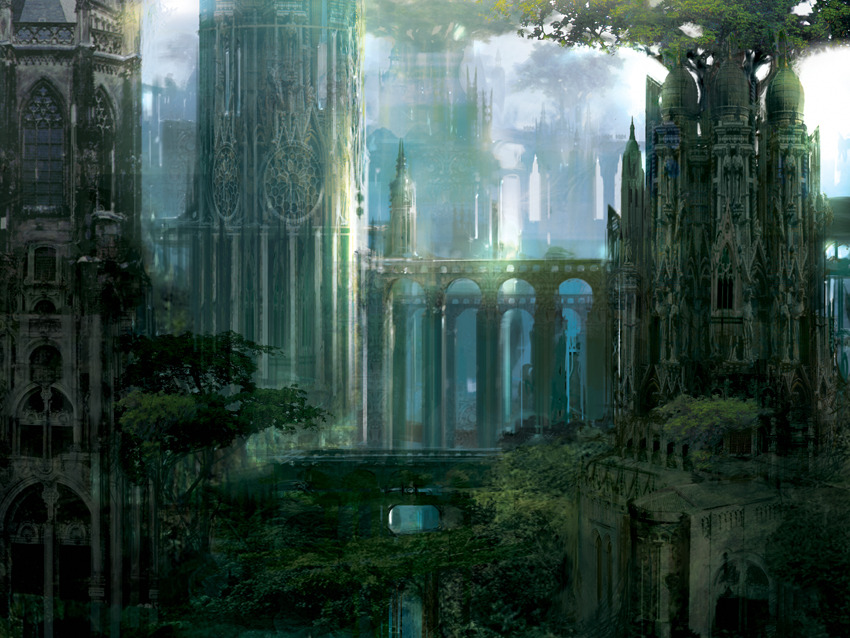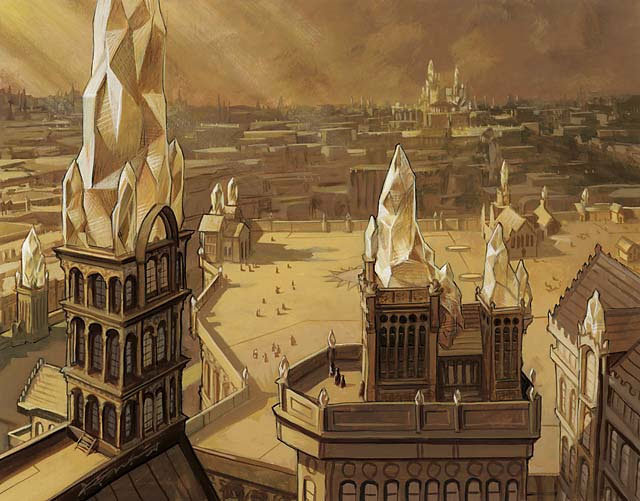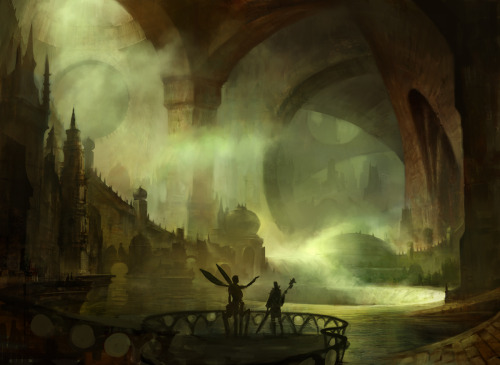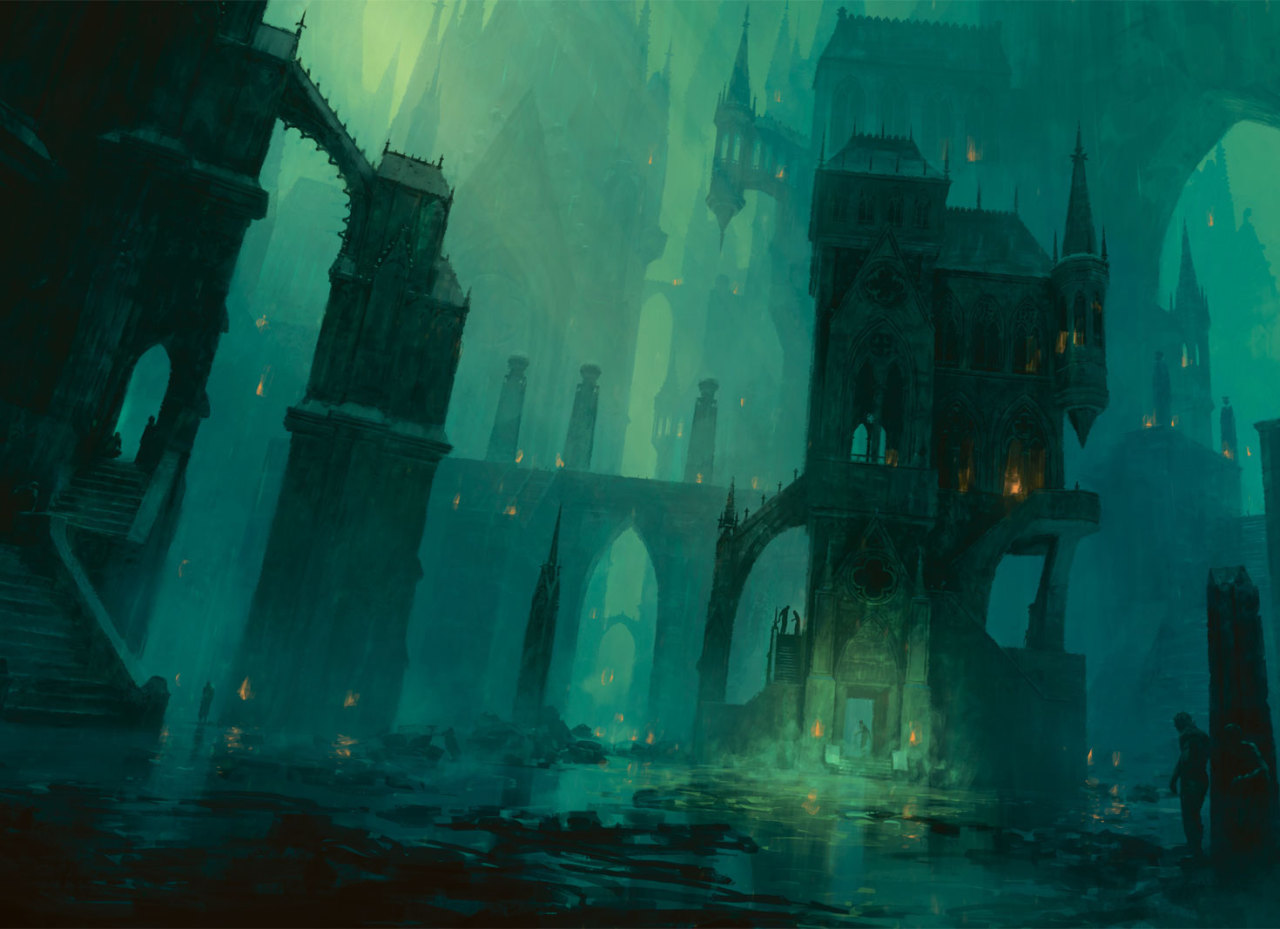
I proposed an alternate color wheel for a Magic like game before and I thought I'd give it a fuller write up. The goal here is not just to make the colors have and aethetic but also to give them a mechanical identity.
Void
Void is themed around sacrifice, decay, resource trading, and entropy. It's nexus(lands) is the Ruin. It's creatures are Zombies, Giant Insects, Mad Cultists, and Horrors from Beyond the Veil. Like Black in Magic Void is interested in sending cards to the graveyard but unlike Black it's not that interested in getting those cards back. Void see a natural life cycle of a card where it starts in you library, gets drawn into your hand, is played, goes to the graveyard, then finally gets exiled and wants to accelerate it as fast a possible skipping steps along the way as needed.
A number of Void's cards require additional costs in the from of life, milling, discard, or exiling cards from the graveyard or library. It's creatures have a certain attraction to the graveyard as well with Vanishing/Fading, when this dies triggers or both. While void can also generate resources it's always at the cost of some other resource, and often void is cute and does stuff like make you pay 3 life to draw two cards in order to hammer home the entropy theme. Of course the big ticket void spells can foist those costs on your opponent instead, the Void doesn't care who pays so long as entropy has increased.
Void Decks break down fairly neatly into aggro, mid-range and control. Aggro Void understands it doesn't matter how much of you deck and life total get's fed to the Void so long as you win before you lose. It deploys large cheap creatures with drawbacks to take an early board advantage and beat down and finishes the game with symmetrical life loss effects. Void also supports midrange attrition decks and control decks through the various cards it has that put you ahead on resources.
Sample Void Cards
Creature-Zombie
Vanishing 3, whenever Rage Zombie enters the battlefield or dies each player loses 1 life.
3/3
Skittering Cockroach 2V
Creature- Insect
When Skittering Horror enters the battlefield target player discards a card.
2/2
Voidspawn 3VVV
Creature- Horror
At the beginning of your upkeep reveal the to three cards of you library put the one with highest cost into your hand and exile the rest. Target Player loses life equal to that cards converted mana cost
6/6
Call of the Void V
Sorcery
Each player sacrifices a creature
Gaze into the Abyss 1V
Sorcery
Pay 3 life draw 2 cards
Hunger of the Beyond 4VVV
Sorcery
Target player loses 6 life, discards three cards, and sacrifices a creature. Gain 5 life Draw 2 cards, and put a creature from your graveyard back into your hand.
Light is pure energy, divinity, and fricking laser beams. It's creatures are Knights, Clerics, Birds, and Angels. It's nexus is the Temple. A lot of Light's mechanical identity is set by it having burn spells. Light has spells that can both be answers and a way of killing the opponent, thus it's the faction that relies on it's spells more.
It's creatures aren't as big as Void or Nature creatures but Knights have various abilities that let them win creature combats like First Strike or Bushido(renamed Chivalry). Clerics on the other hand have various "spells matter" synergy effects. Light doesn't have the same kind of card advantage effects as the other factions but what it does have are Scry effects and various ways to get more out of it's individual spells like flashback or buyback. Light Also gets Ritual spells that generate mana allowing for more explosive all in sorts of plays.
Light decks are primarily aggro decks in the classic sligh model, but also include Midrange and Control decks that are capable of turning the corner rather spectacularly when the time comes.
Sample Light Cards
Creature-Knight
First Strike Chivalry 1
2/2
Priest of Illumination 2L
Creature-Cleric
When Priest of Ilumination enters the battlefield scry 3, whenever you play an instant or sorcery spell Priest of Illumination gets +1/+2.
2/1
Angel of Radiance 3LL
Creature-Angel
Flying, Angel of Radiance enters the battlefield chose an instant or sorcery with CmC 3 or less from your graveyard, you may play it without paying it's mana cost then exile that card.
4/4
Illuminating Bolt 1L
Instant
Illuminating Bolt deals 2 damage to target creature or player. Scy 2
Light of Tomorrow 1LL
Sorcery
Light of Tomorrow deals 4 damage to target creature or player
Flashback 4L
Miracle 5LL
Return all instants and sorceries you own that are in exile to your hand, Add VLLLNTM to your mana pool.
Nature is the ramp and big dudes faction. It's like green but with more access to the sorts of effects that make green deck good, it's dudes are druids and their forest friends and it's nexus is the Grove. It's creatures are bigger for their mana cost like Void creatures but without the drawbacks.
In general Nature does most of what it does through it's creatures, it generates value though creatures enter the battle effects and its removal takes the form of fight effects. Nature also has wolves which do the tribal synergy thing, and various dudes that accumulate +1/+1 counters.
Nature decks tend to take four forms, straight-forward beatdown, synergistic beatdown, midrangey beatdown, and ramp.
Sample Nature Cards
Creature-Wolf
3/3
Howling Wolf 2N
Creature-Wolf
When Howling Wolf enters the battlefield search your library for a wolf and put it into your hand.
2/2
Bloodtusk 3NN
Creature-Beast
When Bloodtusk enters the battlefield reveal cards from your library untill you reveal a creature for converted mana cost 4 or less, put that creature onto the battlefield and then gain life equal to it's toughness.
4/3
Derpasuar 6NN
Creature-Dinosaur
Trample
When Derpasuar enters the battlefield search your library for up to two creatures with a combined CmC 6 or less and put them onto the battlefield.
6/6
Stomp N
Instant
Target creature gets +1/+1 and then fights target creature.
Dryads Song 1N
Sorcery
Search your library for a grove and put it onto the battlefield tapped.
Time is theme around clockwork, wizards, teleportation, and of course time magic. It's creatures are Wizards Arificers, Contructs and Sphinxes. Times nexus is the Tower.
Mechanically time is all about Tempo. Time can be wound backwards untapping permanents, returning them to their owners hand or to the top of their owners library, or it can be spun forward drawing additional cards, allowing a creature to attack the turn it was played or even let you take an additional turn. Time can be stopped tapping a permanent and potentially denying it the ability to untap the next turn and it can "flicker" allowing a creature to be unblockable or "blink" in and out of the exile zone.
Time's creatures just are not as good as other factions an thus rely either on evasion or having potential blockers dealt with some other way. Time also doesn't really have a permanent solution for anything. Cards that are bounced can and will eventually be replayed, creatures that are tapped eventually untap.
Time decks thus fall into aggro-control strategies that trade cards for time or hybrid-control decks that use card draw to refill their hand. Often then hybrid-control decks play to get into a position where they can cast Cronoshift for maximum value.
Sample Time Cards
Creature-Construct
First Strike, Haste
2/1
Timestealer Mage 2T
Creature-Wizard
Haste, When Rewinder Mage enters the battlefield you may return target creature to it's owners hand.
2/2
Sphinx of the Clock Tower 3TT
Creature-Sphinx
Flying, Haste
When Sphinx of the Clock Tower enters the battlefield tap three permanents you don't control they don't untap during their controllers next untap step, then untap three permanents that you control
3/4
Rewind 1T
Instant
Return target spell to it's owners hand, draw a card.
Worldline Connection 2T
Instant
Draw two cards
Cronoshift 2TT
Sorcery
Take an extra turn after this one, exile Cronoshift
Mind deals in the ephemeral it's effects barely touch the battlefield but they can wreak havoc elsewhere. It's creatures are illusions, rogues, scheming viziers, and demons. It's nexus is the Palace.
Mind effects include the coveted counterspell but also targeted discard and tutors. Mind also does mill for what that's worth Where mind falls down is when it comes to dealing with permanents on the battlefield. While mind can take full control of creatures those effects are very high mana cost, inefficient or fragile. However Mind also has spells that do things like prevent a creature from attacking for a turn. Mind also gets shot shrift in the creature department. It's illusions can be big but explode when you look at them, Rogues are evasive but small, and Viziers have low P/T and live or die based on their effects. Demons are fine but they live at the top of the cost curve.
Mind also has the hardest time getting card advantage out of it's cards as it's draw spells tend to be of the look at the top X and select one type, with actual cards advantage being sorcery speed and very high up the curve.
In general mind is a control deck using counter magic and targeted discard to disrupt whatever you opponent is doing until you reach the late game. There's also probably some kind of vizier based turbo mill deck.
Sample Mind Cards
Creature-Vizier
Tap: target player puts the top X+2 cards of his library into his graveyard where X is the number of Viziers you control.
0/3
Beguiling Thief 2M
Creature-Rogue
When Beguiling Thief attacks target creature can't attack or block until the end of it's controlers next turn
2/2
Willstealer Demon 5M
Creature-Demon
Flying
When Willstealer Demon enters the battlefield gain control of target creature for as long as you control Willstealer Demon
5/5
Brainteaser M
Sorcery
Name two card types other than nexus, look at target players hand and chose a card with one of those types that player discards that card.
Gather Thoughts 1M
Instant
Look at the top three cards of your library put one into your hand and the rest on the bottom of your library.
Countermagic 1MM
Instant
Counter Target Spell





